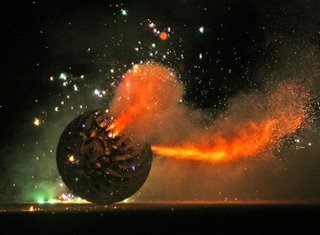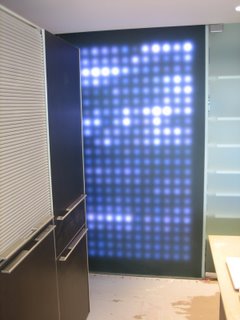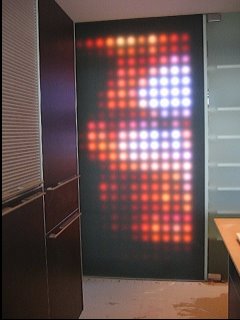June 24, 2009
What color is Twitter?
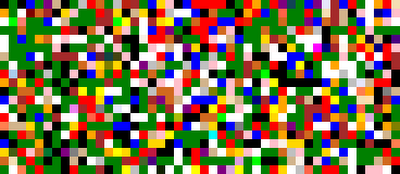
En route to another thing I'm working on, I built a little color scraper that scans the Twitter public timeline for words describing colors. Any word that is a CSS3 web color name (which some of you graybeards may remember as similar to, but not exactly, the X11 colors), is detected and the corresponding R, G, B triple is saved. For example, consider the following tweet:
Finally found the WoW Mt. Dew Game few...the red one is good, but the blue one tastes like ass...
Because I only grabbed the first color in a tweet, the above results in red (255,0,0). Getting a few hundred of these took a day (6/24/2009), as the Twitter API limits how often you can query it. Consequently, most color tweets were missed. However I got enough to make the picture above, where every pixel corresponds to a tweet mentioning that color.
Some things to note:
- ☞ There's a lot of green in there, no doubt due to #iranelection
- ☞ Many color names were metonyms not used to actually describe colors (e.g. White House, "green energy industry")
- ☞ Other occurrences were names from popular culture: e.g. Chris Brown, Black Eyed Peas, Pink.
- ☞ White and black seem to be especially popular descriptions of pets
- ☞ Though not statistically significant, no occurrences of the colors described as "PapayaWhip" or "LavenderBlush" were observed.
- ☞ Though rarely tweeted, I treated hex color codes as valid colors (e.g. "#00FF00"). This caught a few hashtags, (e.g "#ace") for a little random spice.
For your amusement, here is a text file with 300 color triples and the tweets that generated them.
Right, credit due! This was totally easy thanks to Python Twitter Tools and the webcolors library.
June 6, 2009
Song of the Orbs

So we've been refreshing the sound modules on SWARM, and have been experimenting with multitrack audio. The idea is that you can, with one command, get all the orbs to play back different mp3 files at the same time, and they will stay roughly synchronized. Erik found some great multitrack Flaming Lips and a highlight of running the orbs was tooling around on the mothership, very late one night, to the sounds of the Orbs singing.
This sounded so good that I was inspired to make my own music for the Orbs. Originally this was a 64 minute audioscape I procedurally composed as an aid to insomnia (as much as I love Eno's Thursday Afternoon, there's only so many times you can listen to something, plus it's a little sparse to mask noise very well). It's not really a song, as nothing really happens: it's essentially a "Steve Reich ninth chord" (my specialist terminology) with some high-Q filter sweeps that pick out harmonics above. I re-mastered it as six separate stereo tracks, one for each robot; since it's one chord they will naturally harmonize. Seeing as how you likely don't have spare robots rolling around, here it is as one long track to soothe your insomnia (it's not particularly exciting): song_of_the_orbs.mp3 (77 MB)
Photo Credit: Marcus Hertlein
May 25, 2009
Son Shiva
Here's a crisper picture:
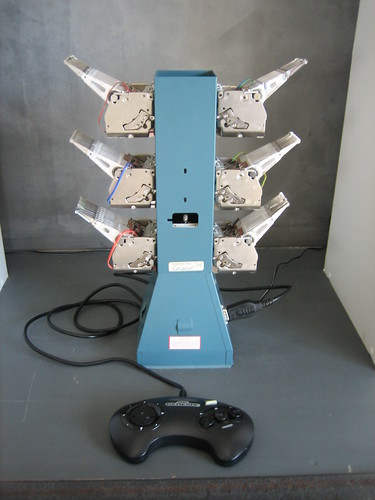
Labels: kinetic, Maker Faire, projects
May 23, 2009
Rotation Simulator
This is a kinetic artwork that digitally simulates rotation and inertia. Turning the knob sequentially triggers eight solenoids arranged in a circle, giving the impression of rotation. The speed and direction is proportional to the knob rotation, and exponential decay simulates rotational friction mimicking an actual rotating object. However the only thing actually rotating is the knob! The LEDs are used as flyback diodes and flash when the magnetic field in the solenoid is switched off.
Here are the guts for those interested in the geeky stuff. As usual, follow the link for an annotated descriptions.
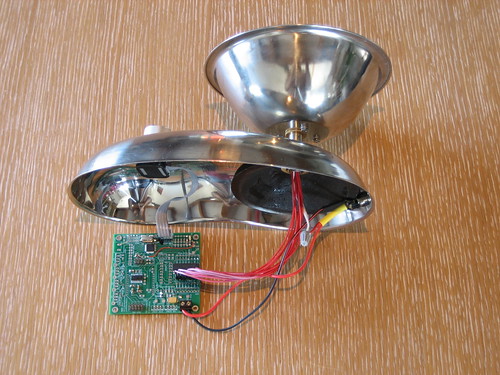
Labels: Maker Faire, projects
May 20, 2009
Ghostmatrix
Ultimately I want to hook this up so it will print tweets. Not there yet, but it will be @ghostmatrix on Twitter. Need to figure out how to get DMs or @replies into an RSS feed, or just buckle down and use the API.
Here's a closeup of the business end. Follow the link to see the labeled parts.
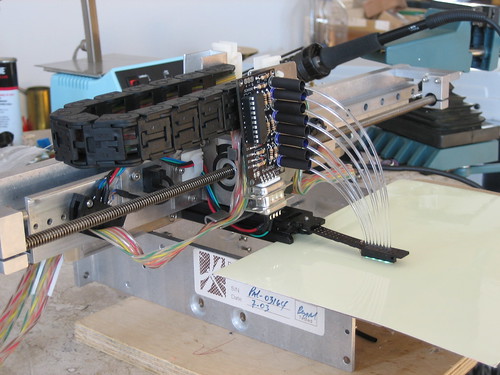
And for you geeks, here's the Frankensteined driver board. I thought it would be easier to reuse the existing board (only need access to 6 signals) but tracing wires on the autorouted multiple-layer board was the very definition of a PITA.
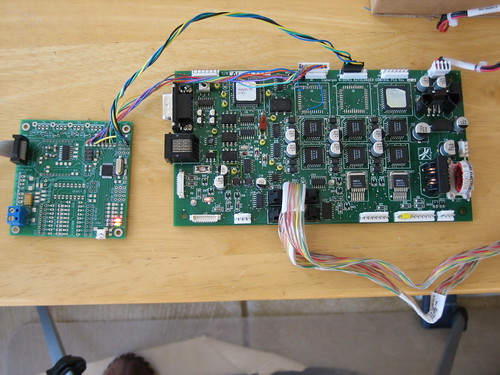
I should give credit where it's due; I used the "Atari-Small" 8x4 font from Tom's X11 Fonts and the spiffing Python bdflib font manipulation library.
UPDATE: some more information about parts and sources: the phosphorescent paper is
Grafix "Funky glow In the Dark" and a web search should get you the source. The lightpipes were (if I recall correctly) purchased from mouser.com. If they are still available I could not find a part number, but a similar (if shorter and more expensive) product is this: http://www.mouser.com/Search/Refine.aspx?Keyword=696-C011701S-150C
Labels: projects
Ripple Matrix
This work is a 8 x 15 array of full-color LEDs, driven by an embedded Linux board. Each LED is addressable, and optical sensors make the work interactive if you touch it. I'm running a digital simulation of the 2-dimensional wave equation. Think of water in the bathtub: it's quiescent when not disturbed. However triggering an optical sensor does the digital equivalent of throwing a rock in a pool: it disturbs the initial conditions, and sends ripples propagating away.
Labels: projects
May 15, 2009
My bitchin' coffee table
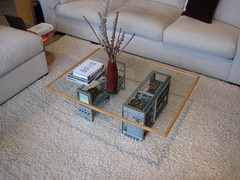
My bitchin' coffee table
This is a coffee table I built from a salvaged Textronix 7704A oscilloscope mainframe I pulled from a dumpster. A sheet of glass on top and a wooden frame complete the table. (I added the frame because I kept bumping my shin on the invisible glass!)
Though I had hopes of resurrecting the scope (originally a 5-figure piece of quality test equipment), it had sat in the rain for a little too long. The PSU in particular had about 14 different output voltages, some of them high, and was completely fried. So I removed some shielding to expose the beautiful insides and made it into a bitchin' coffee table.
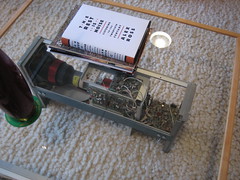
Labels: projects
October 3, 2008
Lights in Interior Design
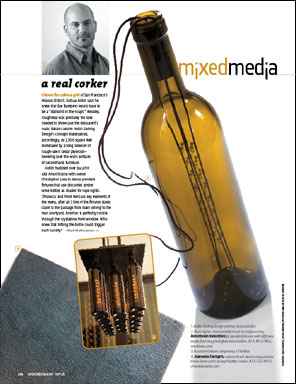 Hey look at that. The lights I designed for Bar Bambino made Interior Design magazine. (So they got a few details wrong, big whoop.)
Hey look at that. The lights I designed for Bar Bambino made Interior Design magazine. (So they got a few details wrong, big whoop.)If you are in the hood (right around the corner from NoiseBridge as it turns out) stop in and have a glass of Lagrein.
Labels: projects, shameless self-promotion
September 7, 2008
Goodness gracious, great balls of fire
May 19, 2008
Chassis has a Posse Website
Hosted by Laughing Squid, natürlich, who took some awesome photos of last week's Roboexotica USA. (We also got some press from Wired, yay).
Thanks to the irrepressible Magnus at SHIFZ and Skot Kuiper for the venue.
Labels: projects, shameless self-promotion
April 12, 2008
Chassis at the San Jose Museum of Art
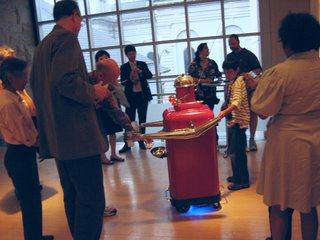 So Chassis had his first paying gig at the SJMA last night. After some opening-night jitters (I can't believe we hooked up the keg tap backwards!) things went completely smoothly, and the beer ran out at precisely 9:00 PM when the reception ended.
So Chassis had his first paying gig at the SJMA last night. After some opening-night jitters (I can't believe we hooked up the keg tap backwards!) things went completely smoothly, and the beer ran out at precisely 9:00 PM when the reception ended.I'm continually surprised and amazed just how willing people are to treat a a vaguely-humanoid piece of junk like a person.
Thanks to Lucky Nora for the photos
Labels: projects, shameless self-promotion
April 9, 2008
Finally done
After more than a year, this custom 1440-LED installation I did for a private residence is finally up. What you see here is less than 1/5 of the whole thing (I couldn't get a shot of the big living room panel because of construction equipment in the way). It came out pretty great. Pictures show snaps of two different video programs ("reflections" and "sparkle"). (I'll get some video up as soon as I can figure out how to rotate it in a way that doesn't break the video sites.)
Source video by Sierra Helvey, installation assistance by Soo-Hwa Yuan, project conception and managment by Peter Noble and Mike Webb of Revolverdesign, architecture by Craig Steely, thanks to Luigi Argento and Philip Springer.
Labels: projects, shameless self-promotion
Subscribe to Posts [Atom]
